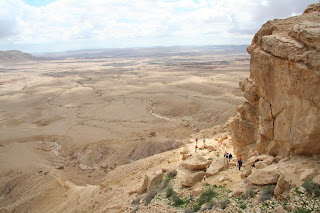 For our Sunday outing we traveled to Abu Ghosh--an Israeli Arab town a few miles west of Jerusalem. It is the site of Biblical Kiriath Yearim. It has two Christian churches (both of which were closed on Sunday?) A Crusader era church is in the lower left. This town overlooks the main road from the coast up to Jerusalem. During the 40s many Arab villages along this road would attack convoys carrying supplies to the Jews of Jerusalem. These Arab villages also played an important role in the battles of 1948. Abu Ghosh was unique in that its residents remained neutral which at the end of the war left them in good standing as new citizens of Israel.
For our Sunday outing we traveled to Abu Ghosh--an Israeli Arab town a few miles west of Jerusalem. It is the site of Biblical Kiriath Yearim. It has two Christian churches (both of which were closed on Sunday?) A Crusader era church is in the lower left. This town overlooks the main road from the coast up to Jerusalem. During the 40s many Arab villages along this road would attack convoys carrying supplies to the Jews of Jerusalem. These Arab villages also played an important role in the battles of 1948. Abu Ghosh was unique in that its residents remained neutral which at the end of the war left them in good standing as new citizens of Israel.













Amazingly the faculty agreed to me taking a jump photo of them. Classic


I love the photos of the Holy Land. Thanks, Chad. Very strange monster. I seem to remember a similar one in Jordan at a restaurant Matt took us to when we were there.
ReplyDeleteSounds like a day well spent. It is good you have been able to document all of your trips on the Blog so you wil have a record of them to remember. We are also glad you found Will's favorite hat!
ReplyDelete